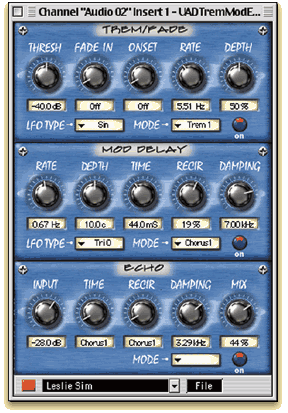UAD-1 Tips & Tricks: Hidden Gems in Nigel
 |
|
Nigel's Trem/Mod/Echo Module
|
"...the Tremolo plugin can give you that backward sound, at a fraction of the cost of a good time machine."
Backwards Compatible
Ever try playing guitar backwards? Unless you have a time machine, you’ll have to settle for playing it forwards, and then “reversing” it in your host application. Now it’s backwards, but is it still a good solo?
Enter the Tremolo plugin. Standalone, or in Nigel, (or even in the TremModEcho plugin), the Tremolo plugin can give you that backward sound, at a fraction of the cost of a good time machine. All you need to do is choose “Fade1” from the MODE menu, and adjust the threshold until the attack of the note is cut off and the note fades in. You can change how fast the note fades in by adjusting the “FADE IN” control. The default of 78ms is a good start. Keep an eye on the red threshold light to see when the threshold is exceeded. Once the threshold is exceeded, the note fades in.
Since the Tremolo plugin is looking for changes in the amplitude of each note, it is best to have little, if any, compression on the input signal. Very high gain distortion can also cause the Tremolo to have problems finding the peaks, reducing the effectiveness of the Fade in Mode. Try putting the distortion after the Tremolo. Another thing that helps the effect is to slightly damp the preceding note just before playing the next note. This assures that the note has dipped below the threshold, so that the attack of the next note is cut off, and the note fades in.
More or Leslie
The TremModEcho (TME) plugin is extremely flexible, and can create a host of effects from sublime vibrato to profound weirdness. Just check the presets and find out.
One effect that unfortunately did not make it into the basic bank of presets was a good Leslie, or rotating speaker simulator. This is easy to do with the TME. But first a little explaining is in order…
The Mod Delay has a mode where it’s rate and depth can be controlled by the Tremolo section, so that they work in sync. If you set the Mod Delay’s LFO type to “Trem U/D”, the Tremolo’s Rate and Depth controls control the Mod Delay’s Rate and Depth. But while the Mod Delay’s Rate control is exclusively controlled by the Tremolo’s Rate control, you can still add more depth with the Mod Delay’s Depth control. I suggest turning up the Depth control in the Tremolo until you are satisfied with the tremolo effect, and then adjust the depth of the Mod Delay to taste (think of the Mod Delay’s Depth control like a fine tuning control).
- As far as settings, I set the Mod Delay like this: Depth = 10 to 15; Time = 0 to 10ms; Recirc = 0 to +/- 20%; and Damping = 5k to 10k.
- Set the Tremolo like this: MODE = Trem1; LFO TYPE = Sin; Rate = 3 to 7 Hz; Depth = 15 to 35%.
- Any controls that were not mentioned do not any effect in the current mode.
- You can also add the Phasor into the Leslie effect, just set it’s rate to either the same rate as the Tremolo, or twice or half as fast.
Not Just for Guitar Anymore
Understandably, most people think of Nigel as only a guitar processor. Keeping with the true spirit of audio engineering, experimentation can unlock many creative doors. Nigel, with its host of audio processors, can add new dimensions to many sources besides guitars.
The compressor plugin is a prime example. It is a different algorithm than any of the compressors included in then UAD-1 bundle, and uses very little DSP power. Try it on a full drum kit or snare with the fastest attack and release times and you will be pleasantly surprised.
The Phasor plugins also sounds great on drums or keyboards. It was designed with a very wide frequency spectrum. All you have to do is set the low sweep to it’s lowest setting, and the high sweep value to its maximum setting.
The ModFilter is also very powerful on percussive instruments. Try using it on drums, and mixing it under the unprocessed dry track.
--Dave Crane
Questions or comments on this article?